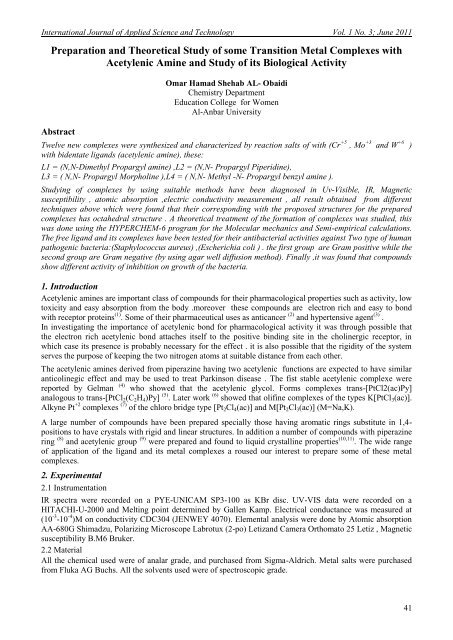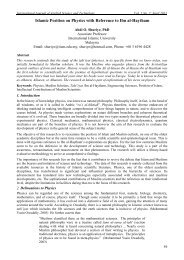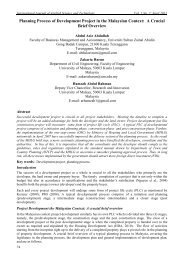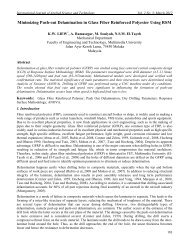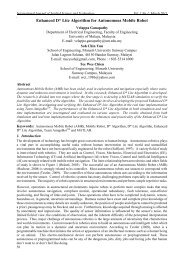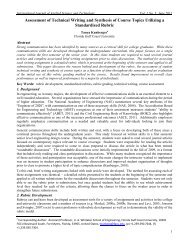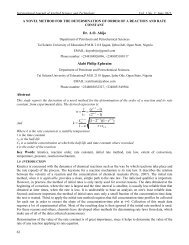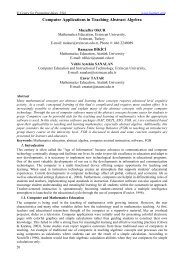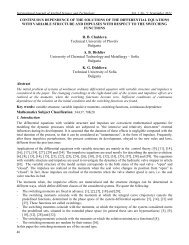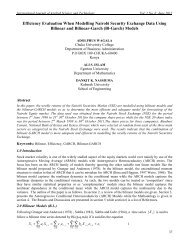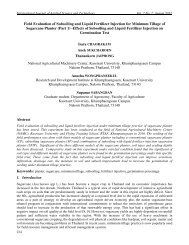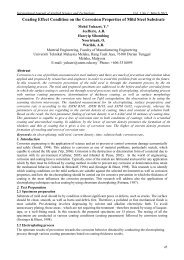Preparation and Theoretical Study of some Transition Metal ...
Preparation and Theoretical Study of some Transition Metal ...
Preparation and Theoretical Study of some Transition Metal ...
Create successful ePaper yourself
Turn your PDF publications into a flip-book with our unique Google optimized e-Paper software.
International Journal <strong>of</strong> Applied Science <strong>and</strong> Technology Vol. 1 No. 3; June 2011<br />
<strong>Preparation</strong> <strong>and</strong> <strong>Theoretical</strong> <strong>Study</strong> <strong>of</strong> <strong>some</strong> <strong>Transition</strong> <strong>Metal</strong> Complexes with<br />
Acetylenic Amine <strong>and</strong> <strong>Study</strong> <strong>of</strong> its Biological Activity<br />
Abstract<br />
Omar Hamad Shehab AL- Obaidi<br />
Chemistry Department<br />
Education College for Women<br />
Al-Anbar University<br />
Twelve new complexes were synthesized <strong>and</strong> characterized by reaction salts <strong>of</strong> with (Cr +5 , Mo +3 <strong>and</strong> W +6 )<br />
with bidentate lig<strong>and</strong>s (acetylenic amine), these:<br />
L1 = (N,N-Dimethyl Propargyl amine) ,L2 = (N,N- Propargyl Piperidine),<br />
L3 = ( N,N- Propargyl Morpholine ),L4 = ( N,N- Methyl -N- Propargyl benzyl amine ).<br />
<strong>Study</strong>ing <strong>of</strong> complexes by using suitable methods have been diagnosed in Uv-Visible, IR, Magnetic<br />
susceptibility , atomic absorption ,electric conductivity measurement , all result obtained from different<br />
techniques above which were found that their corresponding with the proposed structures for the prepared<br />
complexes has octahedral structure . A theoretical treatment <strong>of</strong> the formation <strong>of</strong> complexes was studied, this<br />
was done using the HYPERCHEM-6 program for the Molecular mechanics <strong>and</strong> Semi-empirical calculations.<br />
The free lig<strong>and</strong> <strong>and</strong> its complexes have been tested for their antibacterial activities against Two type <strong>of</strong> human<br />
pathogenic bacteria:(Staphylococcus aureus) ,(Escherichia coli ) . the first group are Gram positive while the<br />
second group are Gram negative (by using agar well diffusion method). Finally ,it was found that compounds<br />
show different activity <strong>of</strong> inhibition on growth <strong>of</strong> the bacteria.<br />
1. Introduction<br />
Acetylenic amines are important class <strong>of</strong> compounds for their pharmacological properties such as activity, low<br />
toxicity <strong>and</strong> easy absorption from the body .moreover these compounds are electron rich <strong>and</strong> easy to bond<br />
with receptor proteins (1) . Some <strong>of</strong> their pharmaceutical uses as anticancer (2) <strong>and</strong> hypertensive agent (3) .<br />
In investigating the importance <strong>of</strong> acetylenic bond for pharmacological activity it was through possible that<br />
the electron rich acetylenic bond attaches itself to the positive binding site in the cholinergic receptor, in<br />
which case its presence is probably necessary for the effect . it is also possible that the rigidity <strong>of</strong> the system<br />
serves the purpose <strong>of</strong> keeping the two nitrogen atoms at suitable distance from each other.<br />
The acetylenic amines derived from piperazine having two acetylenic functions are expected to have similar<br />
anticolinegic effect <strong>and</strong> may be used to treat Parkinson disease . The fist stable acetylenic complexe were<br />
reported by Gelman (4) who showed that the acetylenic glycol. Forms complexes trans-[PtCl2(ac)Py]<br />
analogous to trans-[PtCl 2 (C 2 H 4 )Py] (5) . Later work (6) showed that olifine complexes <strong>of</strong> the types K[PtCl 3 (ac)].<br />
Alkyne Pt +2 complexes (7) <strong>of</strong> the chloro bridge type [Pt 2 Cl 4 (ac)] <strong>and</strong> M[Pt 2 Cl 3 (ac)] (M=Na,K).<br />
A large number <strong>of</strong> compounds have been prepared specially those having aromatic rings substitute in 1,4-<br />
positions to have crystals with rigid <strong>and</strong> linear structures. In addition a number <strong>of</strong> compounds with piperazine<br />
ring (8) <strong>and</strong> acetylenic group (9) were prepared <strong>and</strong> found to liquid crystalline properties (10,11) . The wide range<br />
<strong>of</strong> application <strong>of</strong> the lig<strong>and</strong> <strong>and</strong> its metal complexes a roused our interest to prepare <strong>some</strong> <strong>of</strong> these metal<br />
complexes.<br />
2. Experimental<br />
2.1 Instrumentation<br />
IR spectra were recorded on a PYE-UNICAM SP3-100 as KBr disc. UV-VIS data were recorded on a<br />
HITACHI-U-2000 <strong>and</strong> Melting point determined by Gallen Kamp. Electrical conductance was measured at<br />
(10 -3 -10 -4 )M on conductivity CDC304 (JENWEY 4070). Elemental analysis were done by Atomic absorption<br />
AA-680G Shimadzu, Polarizing Microscope Labrotux (2-po) Letiz<strong>and</strong> Camera Orthomato 25 Letiz , Magnetic<br />
susceptibility B.M6 Bruker.<br />
2.2 Material<br />
All the chemical used were <strong>of</strong> analar grade, <strong>and</strong> purchased from Sigma-Aldrich. <strong>Metal</strong> salts were purchased<br />
from Fluka AG Buchs. All the solvents used were <strong>of</strong> spectroscopic grade.<br />
41
© Centre for Promoting Ideas, USA www.ijastnet .com<br />
2.3 <strong>Preparation</strong> <strong>of</strong> the lig<strong>and</strong><br />
A- L1= (N,N-Dimethyl Propargyl amine) , L2= (N,N- Propargyl Piperidine ),<br />
were prepared according to the literature (5)<br />
B- L3= ( N,N- Propargyl Morpholine ), L4= ( N,N- Methyl -N- Propargyl benzyl<br />
amine ), were prepared according to the method (6) . the lig<strong>and</strong>s are listed in table(1).<br />
2.4 General Procedure for <strong>Preparation</strong> <strong>of</strong> Complexes<br />
All <strong>of</strong> complexes were prepared by the following methods; A solution <strong>of</strong> the lig<strong>and</strong> (2 mmole/l) in absolute<br />
ethanol wee prepared <strong>and</strong> reacted with various metal chlorides in the required molar ratio. To a solution <strong>of</strong> (L)<br />
(2 mmole/l) in absolute ethanol ,a hot ethanolic solution (96%) containing (1 mmole/l) <strong>of</strong> CrCl 3 .6H 2 O was<br />
gradually added with sting the product .the color <strong>of</strong> the resultant mixture changed immediately , the mixture<br />
was left over night . a colored solid precipitate was separated <strong>and</strong> colleted by filtration under vacuo, then it<br />
was washed successively with ethanol <strong>and</strong> recrystallized from absolute ethanol/ether to give colored<br />
complexes . Analogous complexes were prepared in a similar manner to that described above by adding a hot<br />
solution <strong>of</strong> metal chloride (MoCl 5 .6H 2 O or WCl 6 .6H 2 O ) (1 mmole/l) to a solution <strong>of</strong> lig<strong>and</strong> (2 mmole/l) . the<br />
complexes are listed in table(2).<br />
2.5- <strong>Study</strong> <strong>of</strong> biological activity for lig<strong>and</strong>s <strong>and</strong> their metal complexes<br />
The biological activity <strong>of</strong> the lig<strong>and</strong>s <strong>and</strong> their metal complexes were studied against two selected type <strong>of</strong><br />
bacteria which included Escherichia coli as gram negative (-Ve) <strong>and</strong> Staphylococcus aureus as gram positive<br />
(+Ve) to be cultivated <strong>and</strong> as control for the disc sensitivity test (9) , this method involves the exposure <strong>of</strong> the<br />
zone <strong>of</strong> inhibition toward the diffusion <strong>of</strong> micro–organism on agar plat. The plates were incubated for (24<br />
hours) , at 37C° , the zone <strong>of</strong> inhibition <strong>of</strong> bacteria growth around the disc was observed.<br />
3. RESULT AND DISCUSION<br />
3.1 IR Spectra<br />
The spectra <strong>of</strong> all prepared complexes were prepared with lig<strong>and</strong> spectra in the region (4000-200) cm -1 .<br />
stretching vibration <strong>of</strong> (C≡C) bonds for the prepared lig<strong>and</strong> appear near (2100) cm -1 (13) . This peak will shifted<br />
to lower frequency by (490) cm -1 (i.e. to 1750-1650) cm -1 the peak which belong to the frequency (C≡C)<br />
disappeared producing the change in lig<strong>and</strong> peak shape <strong>and</strong> appear intensity more than complex as shown in<br />
table(1). υ M-N frequency appears in the region (315-345) cm -1 which indicating the involving <strong>of</strong> nitrogen<br />
atoms in coordination with metallic ion. In addition, new b<strong>and</strong>s appears attributed to the M-Cl stretching<br />
vibration table(2).<br />
3.2. Electronic Spectra<br />
UV-Visible spectra for the prepared lig<strong>and</strong> show two b<strong>and</strong>s, the first b<strong>and</strong> at (319) nm <strong>and</strong> the second at<br />
(372) nm as shown in table (1).comparing the UV-Vis for free lig<strong>and</strong> solution with metal complexes ,clear<br />
sudden change have been made in b<strong>and</strong>s spots weather increasing o decreasing in wavelength or by new<br />
absorbance b<strong>and</strong> for all preparation complex which belong coordination complex formation ,the change in<br />
color we occurred after mix lig<strong>and</strong>s solution with metal salt, the mixtures color differ free lig<strong>and</strong> <strong>and</strong> metal<br />
salt colors indicate occurring complexation , the data in table (2) clearly show that that b<strong>and</strong>s in all complexes<br />
appear shifted in λmax, compared to the same b<strong>and</strong>s in the free lig<strong>and</strong> signs this b<strong>and</strong> is due to (π-π*) <strong>and</strong>(nπ*)<br />
<strong>and</strong> this shifted in λmax can be to indicate the complexation between lig<strong>and</strong> <strong>and</strong> metal ions (14) .<br />
3.3. Magnetic <strong>Study</strong><br />
From table(2) the magnetic susceptibility were experimentally measured for (Cr +3 , Mo +5 <strong>and</strong> W +6 ) complexes<br />
were correspondences with theoretical data for its complexes (coordination number six) with octahedral<br />
structure (15) .<br />
3.4. Molar Conductance<br />
The measurements <strong>of</strong> the molar electrical conductivity <strong>of</strong> the complexes in DMSO solvent are prepared in<br />
table (2). The results clearly show the high values for the molar conductivity <strong>of</strong> the complexes <strong>of</strong> metal ions<br />
are electrolyte.<br />
3.5. Stoichiometric <strong>Study</strong><br />
Molar ratio (1:2) lig<strong>and</strong> to metal (ML 2 ) was also obtained for the complexes by molar-ratio method as shown<br />
in fig.(1).<br />
42
International Journal <strong>of</strong> Applied Science <strong>and</strong> Technology Vol. 1 No. 3; June 2011<br />
3.6 The proposed structure<br />
Fig. (1): Molar-ratio curve for [Cr(L 1 ) 2 Cl 2 ]Cl <strong>of</strong> prepared complexes<br />
According to the results obtained from ir, uv/vis, molar ratio, molar conductivity <strong>and</strong> atomic absorption<br />
measurements for the prepared complexes, the proposed molecular structure <strong>of</strong> the complexes has an<br />
octahedral structure as shown below fig. (2) .<br />
Fig.(2): The proposed structure <strong>of</strong> [M(L4)2Cl2]Cl x complexes where<br />
M= Cr(III), Mo(V) <strong>and</strong> W(VI).<br />
3.7 <strong>Theoretical</strong> <strong>Study</strong>:<br />
The ball <strong>and</strong> cylinders <strong>and</strong> <strong>some</strong> <strong>of</strong> selected structural parameters (bond length <strong>and</strong> angles) <strong>of</strong> the optimized<br />
geometries are shown in fig.( 3) table (3).<br />
Fig.(3): The optimized structural geometry <strong>of</strong> Cr(III), Mo(V) <strong>and</strong> W(VI) complexes<br />
43
© Centre for Promoting Ideas, USA www.ijastnet .com<br />
As shown in this figure, there is no obvious trend for the variation <strong>of</strong> these parameters. The values <strong>of</strong> the bond<br />
length <strong>and</strong> angles <strong>of</strong> the optimized geometries are quite similar to the experimental results <strong>of</strong> the<br />
corresponding compounds.<br />
3.8 Biological Activity:<br />
Antibacterial activity <strong>of</strong> the lig<strong>and</strong>s <strong>and</strong> its complexes was tested on Gram positive bacteria, Staphylococcus<br />
aureus <strong>and</strong> Gram negative, E. coli, using nutrient agar medium by the well diffusion method (16) . The<br />
antibacterial activities <strong>of</strong> the samples was evaluated by measuring the inhibition zone observed around the<br />
tested materials fig.(4). The values indicate that all metal complexes have higher activity than the free lig<strong>and</strong>s.<br />
Such increase activity <strong>of</strong> the metal chelates can be explained on the basis <strong>of</strong> chelation theory (17) .<br />
Fig(4): The effect <strong>of</strong> lig<strong>and</strong>s <strong>and</strong> their metal complexes toward bacteria<br />
Table(1): physical properties <strong>of</strong> the lig<strong>and</strong>s (L 1 ,L 2, L 3 ).<br />
N<br />
o.<br />
Name <strong>and</strong><br />
structure<br />
<strong>of</strong> compound<br />
Yield<br />
%<br />
colour<br />
M.P<br />
о C<br />
picra<br />
te<br />
Elemental analysis %<br />
cal. (%found )<br />
C H N<br />
IR spectra<br />
cm -1<br />
Uv-Vis.<br />
nm<br />
L 1<br />
N,N-dimethyl<br />
Propargyl Amine<br />
82<br />
Pale<br />
yellow<br />
109-<br />
111<br />
75.62<br />
(75.60)<br />
11.79<br />
(11.76)<br />
12.60<br />
(12.55)<br />
υ(≡CH)3300,<br />
υ(C≡CH)2100<br />
, υ(CH)2950<br />
311,382<br />
In<br />
DMSO<br />
L 2<br />
N-Propargyl<br />
Piperidine<br />
70<br />
Pale<br />
yellow<br />
145-<br />
146<br />
77.99<br />
(77.98)<br />
10.46<br />
(10.42)<br />
11.37<br />
(11.34)<br />
υ(≡CH)3300,<br />
υ(C≡CH)2100<br />
, υ(CH)2968<br />
308,389<br />
In<br />
DMSO<br />
L 3<br />
N-Propargyl<br />
Morpholine<br />
90<br />
Pale<br />
yellow<br />
119-<br />
122<br />
67.17<br />
(67.12)<br />
8.86<br />
(8.83)<br />
11.19<br />
(11.17)<br />
υ(≡CH)3310,<br />
υ(C≡CH)2110<br />
, υ(CH)2960<br />
314,386<br />
In<br />
DMSO<br />
L 4<br />
N-benzyl-N-methyl<br />
prop-2-yn-1-amine<br />
84<br />
Pale<br />
yellow<br />
100-<br />
102<br />
82.97<br />
(82.94)<br />
8.23<br />
(8.21)<br />
8.80<br />
(8.75)<br />
υ(≡CH)3310,<br />
υ(C≡CH)2100<br />
, υ(CH)2978<br />
302,372<br />
In<br />
DMSO<br />
44
International Journal <strong>of</strong> Applied Science <strong>and</strong> Technology Vol. 1 No. 3; June 2011<br />
Table(2): Physical characterization ,analytical <strong>and</strong> Molar Conductance data <strong>of</strong> the compounds<br />
Compound<br />
[Cr(L 1 ) 2 Cl 2 ]Cl 80<br />
Yield<br />
%<br />
Colour<br />
Dark<br />
green<br />
ΔM/<br />
S<br />
cm 2<br />
mol -1<br />
85<br />
[Mo(L 1 ) 2 Cl 2 ]Cl 3 80 blue 95<br />
[W(L 1 ) 2 Cl 2 ]Cl 4 60 Yellow 110<br />
[Cr(L 2 ) 2 Cl 2 ]Cl 70<br />
Dark<br />
green<br />
65<br />
[Mo(L 2 ) 2 Cl 2 ]Cl 3 40 blue 75<br />
[W(L 2 ) 2 Cl 2 ]Cl 4 85 Yellow 100<br />
[Cr(L 3 ) 2 Cl 2 ]Cl 75<br />
Dark<br />
green<br />
60<br />
[Mo(L 3 ) 2 Cl 2 ]Cl 3 70 blue 70<br />
[W(L 3 ) 2 Cl 2 ]Cl 4 65 Yellow 80<br />
[Cr(L 4 ) 2 Cl 2 ]Cl 65<br />
Dark<br />
green<br />
70<br />
[Mo(L 4 ) 2 Cl 2 ]Cl 3 70 blue 85<br />
[W(L 4 ) 2 Cl 2 ]Cl 4 55 Yellow 90<br />
M.P<br />
C˚<br />
160-<br />
162<br />
192-<br />
194<br />
210-<br />
212<br />
165-<br />
167<br />
195-<br />
197<br />
203-<br />
205<br />
173-<br />
175<br />
187-<br />
189<br />
195-<br />
197<br />
158-<br />
160<br />
175-<br />
177<br />
215-<br />
217<br />
UV/VIS<br />
nm<br />
309,382,<br />
615<br />
295,374,<br />
461<br />
297,382,<br />
424<br />
319,380,<br />
635<br />
300,333,<br />
495<br />
297,370,<br />
475<br />
306,387,<br />
630<br />
299,339,<br />
415<br />
286,377,<br />
388<br />
310,383,<br />
625<br />
300,382,<br />
445<br />
296,372,<br />
440<br />
µ eff<br />
(BM)<br />
3.7<br />
-<br />
-<br />
3.74<br />
-<br />
-<br />
3.71<br />
-<br />
-<br />
3.77<br />
-<br />
-<br />
Elemental analysis<br />
(% found) % cal<br />
Cl<br />
(27.95)<br />
27.96<br />
(35.75)<br />
35.79<br />
(34.35)<br />
34.39<br />
(26.26)<br />
26.30<br />
(34.11)<br />
34.14<br />
(33.08)<br />
33.10<br />
(26.00)<br />
26.04<br />
(33.85)<br />
33.88<br />
(32.88)<br />
32.90<br />
(22.29)2<br />
2.32<br />
(28.86)2<br />
9.98<br />
(29.75)2<br />
9.77<br />
M<br />
(13.63)<br />
13.65<br />
(19.35)<br />
19.36<br />
(29.68)<br />
29.70<br />
(12.81)<br />
12.84<br />
(22.84)<br />
22.86<br />
(28.56)<br />
28.59<br />
(12.69)<br />
12.71<br />
(18.29)<br />
18.32<br />
(28.39)2<br />
8.42<br />
(10.87)1<br />
0.90<br />
(16.18)1<br />
6.21<br />
(25.68)2<br />
5.71<br />
IR spectra<br />
cm -1<br />
υ (C≡C) 1680 (s) ,<br />
υ (M-N) 295 (m) ,<br />
υ (M-Cl) 340 (w)<br />
υ (C≡C) 1705 (s) ,<br />
υ (M-N) 315 (s) ,<br />
υ (M-Cl) 335 (w)<br />
υ (C≡C) 1695 (s) ,<br />
υ (M-N) 270 (m) ,<br />
υ (M-Cl) 345 (w)<br />
υ (C≡C) 1740 (s) ,<br />
υ (M-N) 318 (s) ,<br />
υ (M-Cl) 338 (w)<br />
υ (C≡C) 1695 (s) ,<br />
υ (M-N) 260 (w) ,<br />
υ (M-Cl) 325 (m)<br />
υ (C≡C) 1710 (s) ,<br />
υ (M-N) 290 (w) ,<br />
υ (M-Cl) 3500 (s)<br />
υ (C≡C) 1675 (s) ,<br />
υ (M-N) 290 (m) ,<br />
υ (M-Cl) 398 (w)<br />
υ (C≡C) 1685 (s) ,<br />
υ (M-N) 305 (s) ,<br />
υ (M-Cl) 405 (w)<br />
υ (C≡C) 1690 (s) ,<br />
υ (M-N) 275 (m) ,<br />
υ (M-Cl) 395 (w)<br />
υ (C≡C) 1680 (s) ,<br />
υ (M-N) 328 (s) ,<br />
υ (M-Cl) 410 (w)<br />
υ (C≡C) 1690 (s) ,<br />
υ (M-N) 280 (w) ,<br />
υ (M-Cl) 415 (m)<br />
υ (C≡C) 1685 (s) ,<br />
υ (M-N) 295 (w) ,<br />
υ (M-Cl) 400 (s)<br />
45
© Centre for Promoting Ideas, USA www.ijastnet .com<br />
Table (3) : structural parameters, bond length (ºA) <strong>and</strong> angles(º) <strong>of</strong> the studied Molecules.<br />
Parameter<br />
Bond lengths (ºA)<br />
C(29)-H(61) 1.1000 1.1000 C(17)-H(51) 1.1130 1.1130 C(10)-H(41) 1.0900 1.0900 C(29)-C(24) 1.3370 1.4200<br />
C(16)-C(24) 1.4970 1.4970 C(18)-C(19) 1.3370 1.4200 N(2)-C(17) 1.4380 1.4380 N(7)-C(16) 1.4380 1.4380<br />
Du(11)-Cl(15) 1.9900 Du(11)-Cl(14) 1.9900 N(2)-Du(11) 1.6760 N(7)-Du(11) 1.6760<br />
C(13)-Du(11) 1.7700 C(12)-Du(11) 1.7700 N(7)-C(8) 1.4380 1.4380 C(6)-N(7) 1.4380 1.4380<br />
N(2)-C(3) 1.4380 1.4380 N(2)-C(1) 1.4380 1.4380 H(61)-C(29)-C(24) 120.0000 120.0000<br />
C(24)-C(29)-C(28) 120.0000 1.4200 C(29)-C(24)-C(16) 120.0000 121.4000 C(22)-C(21)-C(20) 120.0000 1.4200<br />
C(21)-C(20)-C(19) 120.0000 1.2600 C(20)-C(19)-C(18) 120.0000 1.5030 C(23)-C(18)-C(17) 120.0000 121.4000<br />
H(51)-C(17)-H(50) 109.5200 109.4000 H(51)-C(17)-C(18) 109.4620 109.4100 H(51)-C(17)-N(2) 109.4620 1.4200<br />
H(50)-C(17)-N(2) 109.4420 1.4200 C(18)-C(17)-N(2) 109.5000 1.4200 H(49)-C(16)-N(7) 109.4620 1.4200<br />
H(48)-C(16)-N(7) 109.4420 1.4200 C(24)-C(16)-N(7) 109.5000 1.4200 H(47)-C(13)-Du(11) 109.4620 1.4200<br />
H(46)-C(13)-Du(11) 109.4420 1.4200 H(45)-C(13)-Du(11) 109.5000 1.4200 H(44)-C(12)-Du(11) 109.4620 1.4200<br />
H(43)-C(12)-Du(11) 109.4420 1.4200 H(42)-C(12)-Du(11) 109.5000 1.4200 Cl(15)-Du(11)-Cl(14) 177.2240 1.4200<br />
Cl(15)-Du(11)-N(2) 89.8528 1.4200 Cl(15)-Du(11)-N(7) 87.2239 Cl(15)-Du(11)-C(13) 92.7722 Cl(15)-Du(11)-C(12)<br />
90.1472<br />
Cl(14)-Du(11)-N(2) 90.0000 Cl(14)-Du(11)-N(7) 90.0000 Cl(14)-Du(11)-C(13) 90.0000 Cl(14)-Du(11)-C(12) 90.0000<br />
N(2)-Du(11)-N(7) 86.9600 N(2)-Du(11)-C(13) 90.0000 N(2)-Du(11)-C(12) 180.0000 N(7)-Du(11)-C(13) 176.9600<br />
N(7)-Du(11)-C(12) 93.0400 C(13)-Du(11)-C(12) 90.0000 H(39)-C(8)-N(7) 109.4420 C(9)-C(8)-N(7) 109.5000<br />
C(16)-N(7)-Du(11) 76.1677 C(16)-N(7)-C(8) 101.3470 C(16)-N(7)-C(6) 92.4261 Du(11)-N(7)-C(8) 120.0000<br />
C(8)-N(7)-C(6) 120.0000 H(38)-C(6)-N(7) 109.4620<br />
Bond angles(º)<br />
N(2)-C(17) 1.4380 1.4380 Du(11)-Cl(15) 1.9900 Du(11)-Cl(14) 1.9900 N(2)-Du(11) 1.6760 N(7)-Du(11) 1.6760<br />
C(13)-Du(11) 1.7700 C(12)-Du(11) 1.7700 N(7)-C(8) 1.4380 1.4380 C(6)-N(7) 1.4380 1.4380 N(2)-C(3)<br />
1.4380 1.4380 N(2)-C(1) 1.4380 1.4380 H(51)-C(17)-N(2) 109.4620 1.4200 H(50)-C(17)-N(2) 109.4420 1.4200<br />
C(18)-C(17)-N(2) 109.5000 C(13)-Du(11)-C(12) 90.0000 H(40)-C(8)-N(7) 109.4620 H(39)-C(8)-N(7) 109.4420<br />
C(9)-C(8)-N(7) 109.5000 C(16)-N(7)-Du(11) 76.1677 C(16)-N(7)-C(8) 101.3470 Du(11)-N(7)-C(8) 120.0000<br />
Du(11)-N(7)-C(6) 120.0000 H(38)-C(6)-N(7) 109.4620 H(37)-C(6)-N(7) 109.4420 H(36)-C(6)-N(7) 109.5000<br />
H(34)-C(3)-N(2) 109.4620 124.3000 H(33)-C(3)-N(2) 109.4420 120.0000 C(4)-C(3)-N(2) 109.5000 120.0000<br />
C(17)-N(2)-Du(11) 177.1540 120.0000 C(17)-N(2)-C(3) 57.1535 120.0000 Du(11)-N(2)-C(3) 120.0000<br />
Du(11)-N(2)-C(1) 120.0000 120.0000 C(3)-N(2)-C(1) 120.0000 120.0000 H(32)-C(1)-N(2) 109.4620 120.0000<br />
H(31)-C(1)-N(2) 109.4420 120.0000 H(30)-C(1)-N(2) 109.5000 120.0000<br />
References<br />
1- J.F. Ruffled," Acetylenic compounds" , einhold book coporation, new york;314, (1968).<br />
2- D.Lednicer,"Organu\ic chemistry <strong>of</strong> drug synthesis ", vol,1,(1966).<br />
3- D.R.Learence,"Clinical pharmacology", p232-234, 2 nd ed. (1963).<br />
4- H.H.Jaffo, Chem.Rev.,53,191(1953).<br />
5- E.O.Chiai,"Aromatic Amine Oxide",Amsterdam,p15-17,(1967).<br />
6- J.Chatt,L.A.Ducanson <strong>and</strong> R.G.Guy;Nature,184(1959).<br />
7- Ibid.,827 (1961).<br />
8- A.K.Kinashi,S.Takenaka <strong>and</strong> Kuseba Yash,. Mol., Crys., 67,49(1981).<br />
9- A.H.Samir,M.Sc. Thesis, Baghdad University, Ibn-Alhaitham Education Collage (1997).<br />
10- M.V.Rajasekn aran <strong>and</strong> P.T.Manoharan, Mol.Crys.Liq.Cry.,59,pp.197-206(1980).<br />
11- M.Ghedini,M.Longeri,ibid.,84,pp.207-211(1982).<br />
12- V.B.Mochaline <strong>and</strong> T.S. Minervina, Zr.Og.Khim.,1 (10), 1725 (1965).<br />
13- K. Nakamato,'Infrared <strong>and</strong> Raman Spectra <strong>of</strong> inorganic <strong>and</strong> coordination compond', 4 th Ed,Wiley<br />
intescince,New York, (1968).<br />
14- M. Siroki<strong>and</strong> , M. Koren-Markovic,"Solvent Extraction <strong>and</strong> ion Exchangs", 6,771,(1988).<br />
15- B.N.Figgis," Introduction to Lig<strong>and</strong> Fields", Interscince ,New Yok (1966).<br />
16- C. Perez , M. Pauli <strong>and</strong> P. Bazevque , Acta Biol. Med. Exp. 15, 113, (1970).<br />
17- B. G. Twedy , Phytopathology , 55, 910, (1964).<br />
46


